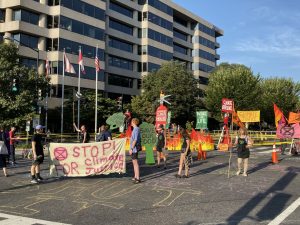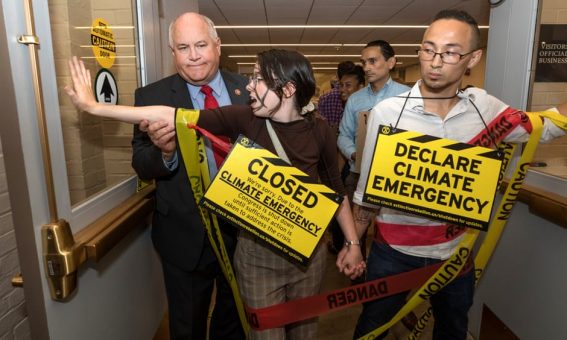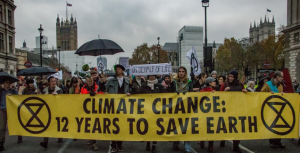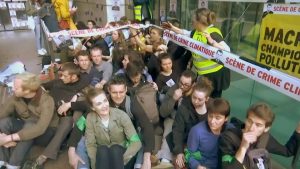Shut Down DC organizers urged “climate rebels” to flood the District’s streets to bring “the whole city to a gridlocked standstill,” according to the group’s website. Sites were chosen for traffic volume and also their proximity to the offices of “climate criminals,” organizers said, such as petroleum companies or lobbyists for the oil and gas industry.
The protest comes after youth-led protests in more than 150 countries Friday ahead of a United Nations climate summit Monday, where policymakers were urged to aggressively take up climate change.
Protesters shut down parts of K Street, Dupont Circle and Connecticut Avenue, as well as 4th Street and New York Avenue NW — forcing police to divert traffic at the 3rd Street Tunnel. Kaela Bamberger, a spokeswoman for the Coalition to Shut Down D.C., said the protest is an escalation in tactics to draw attention to a warming planet.
 “I think that we were very successful in holding the majority of the blockades people had planned,” Bamberger said. “We significantly impeded traffic in some of the main areas we were in for about three hours.”
“I think that we were very successful in holding the majority of the blockades people had planned,” Bamberger said. “We significantly impeded traffic in some of the main areas we were in for about three hours.”
Transportation officials had warned commuters last week to allow extra time and expect delays on their normal routes. Commuters also were advised to try other modes, including biking or taking Metro — or the best bet, transportation experts suggested, might be telework.
Shut Down DC organizers said protesters had set up blockades at 22 District locations at various times.
Protesters chained themselves to a boat to block the intersection of 16th and K streets NW in downtown Washington, three blocks north of the White House grounds. D.C. police used power tools to cut the bonds, covering protesters with riot shields and fire blankets as sparks flew.
Waiting to be cut from the boat, a 22-year-old protester who identified himself only as George as he risked arrest shouted to a reporter outside the police cordon that he had chained himself to the boat around 7 a.m. and wasn’t sure when he would be cut free. He said the action was necessary to bring attention to the “climate crisis.”
“I’m doing something that’s right, moral and just,” he said. “I’m doing this so I can look my kids in the eye one day.”
Jeffrey Johnson watched as a protester was being cut from the boat at around 8:20 a.m. The protest hadn’t disrupted his commute — he’s an “early bird,” he said, starting work around 6 a.m. at a high-end downtown hotel.
“I don’t even know what the message is,” he said. “They need to get some signs up.”
But Johnson appeared broadly supportive of any critique of the current occupant of 1600 Pennsylvania Avenue.
“They’re protesting in the wrong place,” he said. “It should be two blocks up where that knucklehead is at.”
Other commuters seemed to take the delays in stride.
Sitting in a car at 16th and L streets NW, Jackie Hilliard tried to remain philosophical about her delayed commute.
She had been “detoured,” she said, circling through downtown after a failed attempt to make a right on Rhode Island Avenue on the way to her job at a law firm. The net effect on her commute wouldn’t be that bad — an 11-minute delay — but she didn’t like being late.
She also didn’t want to get too distraught about it.
“I don’t care,” she said. “It is what it is. There’s no use getting upset over something I have no control over.”
At least one D.C. school opened later Monday because of the expected gridlock. Basis DC, a downtown charter middle and high school, informed families Friday that the school would open two hours late because of possible delays stemming from the protest.
By 7 a.m. Monday, health-care workers and other activists had gathered at Folger Park on Capitol Hill. They marched toward Independence and Washington avenues in Southwest, intermittently blocking traffic. After being pushed back by police onto the sidewalk, they set up a tent outside the Department of Health and Human Services, where nurses and physicians conducted high blood pressure and glucose screenings for a few passersby. The tents were taken down by 9:30 a.m.
Southeast D.C. resident Jerry Griffin was on his way to work downtown when he got caught in the traffic mess. After getting stuck at Independence and Washington avenues in Southwest, followed by further delays elsewhere, Griffin said he missed an 8:30 a.m. meeting and decided to drive back home.
While Griffin said he agreed with protesters that action is needed on climate change, he didn’t like the disruption to Washington’s already-messy traffic. He said protesters were inconveniencing “the everyman” rather than those in positions of power.
“Do I approve of efforts to address climate change? Yes,” Griffin said. “Do I approve of a sit-in on a main thoroughfare during rush hour on Monday? People can be terminated because of this — not so much.”
Not everyone was as frustrated.
Don Smith, a small-business owner in the District, texted clients to apologize for missing a meeting. Even though it affected his work, he said he was glad the strike occurred.
“I’m inconvenienced, but I’m all for it,” he said. “Civil unrest is how this country was founded. As an American, I’m proud of them.”
As the crowd marched down 2nd Street NE toward Independence Avenue, their voices rang loudly in the empty streets. Some bleary-eyed townhouse residents peered out from their windows; several passing joggers cheered them on.
“The house is on fire!” the group chanted. “Put the fire out!”
A D.C. police spokeswoman said no specific street closures were planned ahead of the protests, but rolling closures occurred where protesters showed up. Authorities on Monday didn’t respond to questions about police procedures during the event.
One Lyft driver named Jude, who didn’t want to give his last name because he wasn’t authorized to speak publicly, said Monday he had no idea about the protests.
“I haven’t gotten an alert on my phone or anything,” he said at 8 a.m. as he drove south from Petworth. “But I’ve also been paying less attention to the news.”
He said he wasn’t worried about hitting roadblocks from demonstrations and would call passengers who might be waiting for him to inform them of delays. During a recent Women’s March demonstration, Jude said, he suffered five cancellations from passengers who waited 20 minutes or longer for a ride.
While he hates lost business, he said, he also saw opportunity. The Women’s March provided some of his best fares, the result of the upcharge Lyft instituted because of demand, he said.
Motorists who began the week with citywide protests could end the week in similar fashion.
Bamberger said activists decided Monday afternoon to return to District streets Friday — the final day of coordinated climate change strikes worldwide. Specific protest sites haven’t been selected, but she called Monday’s demonstation “a huge success.”
“I might remind the disgruntled drivers that we are responding to the youth call for action on climate change,” she said. “Their futures are at stake.”









